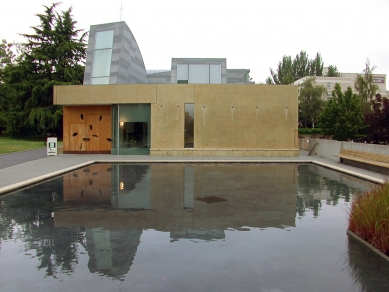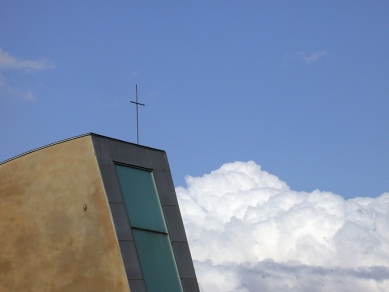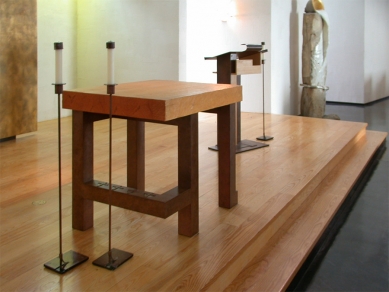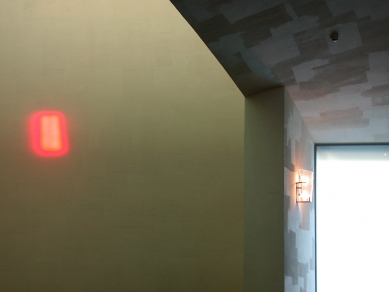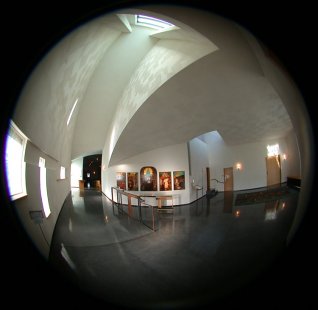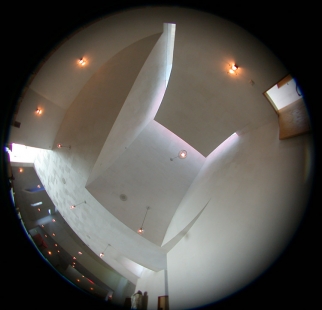
Chapel of St. Ignatius

For the first time in my life, I experienced the inability to retain and envision a building in my mind. Clearly, it is a sandstone-colored concrete box with randomly, scientifically, or artistically placed forms on the roof. But when one steps inside, an absolutely amazing space opens up, where the structural engineer must suffer and the mortal must find God. And I have not yet mentioned the light for which Steven Holl is famous (or did he make light famous?).
I had the opportunity to visit the building at all times of the day, in every weather condition, in every seasonal climate, and the light always created a different atmosphere inside. However, the best description was provided by a knowledgeable local native, who suggested how it looks in the rain. The concrete takes on a rich yellow hue, the metal roof gleams glassily, the overcast sky dims the effect of the colored glass, and everywhere there flows a honeyed light from the primitively-shaped, hand-crafted lamps.
I also discovered the beauty of playing with materials to the point of absurdity: a beeswax surface in the Chapel of Reconciliation, profiled glass with motifs, carved entrance doors made of Alaskan cedar, and textured scratch-coat plaster—everything exudes a sense of humanity and its work.
blue › yellow
yellow › blue
green › red
red › green
orange › purple
purple › orange
the seventh color is the color of daylight
Facts:
Architect Steven Holl chose "A Gathering of Different Lights" as the guiding concept for the design of the Chapel of St. Ignatius. This metaphor describes Seattle University's mission and it also refers to St. Ignatius' vision of the spiritual life as comprising many interior lights and darknesses, which he called consolations and desolations.
Holl conceived of the chapel as "seven bottles of light in a stone box," with each bottle or vessel of light corresponding to a focal aspect of Catholic worship. Light passes through each bottle in a specific area of the building to define physical and spiritual spaces with pools of clear and colored light. During the day, each part of the chapel will glow with colored light from two sources. Light bouncing off color fields painted on the back of suspended baffles creates a halo of light on the surrounding walls, while light passing through colored glass lenses in the exterior windows and openings in the baffles casts onto the chapel walls and floor. Interior lighting will create a similar effect at night, transforming the chapel into a beacon of multicolored light radiating outward to the campus and city.
The chapel design and construction have, from the outset, been focused on the spiritual needs of students. Student contributions were central to the design process. "I think there has been more student input on this job than any other university project I have done," said Holl. Student comments helped anchor the design, and according to Holl, the result was "a design that would be forward looking, but anchored in the past."
Holl's plan for the chapel won a design award from the New York Chapter of the American Institute of Architects, and the scale model of the chapel has been selected to become part of the permanent collection of the Museum of Modern Art in New York.
Most of the building's furnishings and architectural details were designed by the architect and fabricated by local artisans.
About St. Ignatius:
In 1491, Saint Ignatius of Loyola, the founder of the Society of Jesus (the Jesuit order), was born Inigo de Loyola to a wealthy Basque family near Azpeitia, Spain. In his youth, he often attended the court of Ferdinand and Isabella and was known to engage in worldly indulgences and the darker intrigues common to young courtiers of his day. In 1517, Ignatius joined the army of the Duke of Najera. He was wounded by cannon fire during a French siege of Pamplona in 1521, suffering severe leg wounds. During a long period of recovery, he endured great physical pain as his legs were broken and reset only to later be stretched to correct a surgical error. While forced to a bedridden lifestyle, Ignatius read texts describing the life of Christ and the lives of the saints. He became fascinated with the pious deeds of the saints and realized it was a greater thing to compete with their acts of faith than to compete with soldiers in the manly arts of war.
God took hold of him and led him away from a life rooted in earthly pleasures and prepared him to lead others in many good works. Later, at the altar of the Virgin Mary in a Benedictine monastery in Montserrat, Ignatius hung up his sword and rededicated his life to the service of God. During the following two years, Ignatius took on a monastic lifestyle, living in a cave, and enduring bodily discomfort. During this time he experienced several visions and recorded what he learned in The Spiritual Exercises, a tract describing techniques of prayer and spiritual focus. He then traveled to Paris to study theology and the humanities from 1528 to 1535; Ignatius was ordained in 1537.
In 1534, Ignatius and six other men founded the Society of Jesus, all taking vows of chastity, poverty, and loyalty to the Pope. In 1540, Pope Paul III approved the order with a membership limit of 60 men, and in 1544 this limit was lifted. The Jesuit order was pivotal in the spread of God's Word, establishing missions and schools throughout the New World, Asia, and Africa. The order is noted for its strong emphasis on education and the over 30 major universities it has founded throughout the world.
Ignatius led the order during its first sixteen years as the group grew to some 1000 members. During his life, he served as a mentor to later influential Jesuits such as Saint Peter Faber and Saint Francis Xavier. He established the constitution for his order. This constitution established precedents in both the form and function of such constitutions for later orders. He charged the order to educate the young and ignorant of all classes, establish foreign missions, and to minister to the sick and imprisoned.
Ignatius was beatified by Paul V on July 27, 1609. He was canonized on May 22, 1622, by Gregory XV. The Feast of Saint Ignatius of Loyola is on July 31.
I had the opportunity to visit the building at all times of the day, in every weather condition, in every seasonal climate, and the light always created a different atmosphere inside. However, the best description was provided by a knowledgeable local native, who suggested how it looks in the rain. The concrete takes on a rich yellow hue, the metal roof gleams glassily, the overcast sky dims the effect of the colored glass, and everywhere there flows a honeyed light from the primitively-shaped, hand-crafted lamps.
I also discovered the beauty of playing with materials to the point of absurdity: a beeswax surface in the Chapel of Reconciliation, profiled glass with motifs, carved entrance doors made of Alaskan cedar, and textured scratch-coat plaster—everything exudes a sense of humanity and its work.
Petr Šmídek, 2001
Complementary colors in the Chapel of St. Ignatius:blue › yellow
yellow › blue
green › red
red › green
orange › purple
purple › orange
the seventh color is the color of daylight
Facts:
Architect Steven Holl chose "A Gathering of Different Lights" as the guiding concept for the design of the Chapel of St. Ignatius. This metaphor describes Seattle University's mission and it also refers to St. Ignatius' vision of the spiritual life as comprising many interior lights and darknesses, which he called consolations and desolations.
Holl conceived of the chapel as "seven bottles of light in a stone box," with each bottle or vessel of light corresponding to a focal aspect of Catholic worship. Light passes through each bottle in a specific area of the building to define physical and spiritual spaces with pools of clear and colored light. During the day, each part of the chapel will glow with colored light from two sources. Light bouncing off color fields painted on the back of suspended baffles creates a halo of light on the surrounding walls, while light passing through colored glass lenses in the exterior windows and openings in the baffles casts onto the chapel walls and floor. Interior lighting will create a similar effect at night, transforming the chapel into a beacon of multicolored light radiating outward to the campus and city.
The chapel design and construction have, from the outset, been focused on the spiritual needs of students. Student contributions were central to the design process. "I think there has been more student input on this job than any other university project I have done," said Holl. Student comments helped anchor the design, and according to Holl, the result was "a design that would be forward looking, but anchored in the past."
Holl's plan for the chapel won a design award from the New York Chapter of the American Institute of Architects, and the scale model of the chapel has been selected to become part of the permanent collection of the Museum of Modern Art in New York.
Most of the building's furnishings and architectural details were designed by the architect and fabricated by local artisans.
About St. Ignatius:
In 1491, Saint Ignatius of Loyola, the founder of the Society of Jesus (the Jesuit order), was born Inigo de Loyola to a wealthy Basque family near Azpeitia, Spain. In his youth, he often attended the court of Ferdinand and Isabella and was known to engage in worldly indulgences and the darker intrigues common to young courtiers of his day. In 1517, Ignatius joined the army of the Duke of Najera. He was wounded by cannon fire during a French siege of Pamplona in 1521, suffering severe leg wounds. During a long period of recovery, he endured great physical pain as his legs were broken and reset only to later be stretched to correct a surgical error. While forced to a bedridden lifestyle, Ignatius read texts describing the life of Christ and the lives of the saints. He became fascinated with the pious deeds of the saints and realized it was a greater thing to compete with their acts of faith than to compete with soldiers in the manly arts of war.
God took hold of him and led him away from a life rooted in earthly pleasures and prepared him to lead others in many good works. Later, at the altar of the Virgin Mary in a Benedictine monastery in Montserrat, Ignatius hung up his sword and rededicated his life to the service of God. During the following two years, Ignatius took on a monastic lifestyle, living in a cave, and enduring bodily discomfort. During this time he experienced several visions and recorded what he learned in The Spiritual Exercises, a tract describing techniques of prayer and spiritual focus. He then traveled to Paris to study theology and the humanities from 1528 to 1535; Ignatius was ordained in 1537.
In 1534, Ignatius and six other men founded the Society of Jesus, all taking vows of chastity, poverty, and loyalty to the Pope. In 1540, Pope Paul III approved the order with a membership limit of 60 men, and in 1544 this limit was lifted. The Jesuit order was pivotal in the spread of God's Word, establishing missions and schools throughout the New World, Asia, and Africa. The order is noted for its strong emphasis on education and the over 30 major universities it has founded throughout the world.
Ignatius led the order during its first sixteen years as the group grew to some 1000 members. During his life, he served as a mentor to later influential Jesuits such as Saint Peter Faber and Saint Francis Xavier. He established the constitution for his order. This constitution established precedents in both the form and function of such constitutions for later orders. He charged the order to educate the young and ignorant of all classes, establish foreign missions, and to minister to the sick and imprisoned.
Ignatius was beatified by Paul V on July 27, 1609. He was canonized on May 22, 1622, by Gregory XV. The Feast of Saint Ignatius of Loyola is on July 31.
The English translation is powered by AI tool. Switch to Czech to view the original text source.
0 comments
add comment




